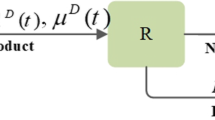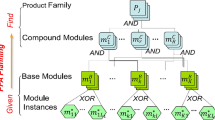Abstract
Existing conjoint approaches to optimal new product design have focused on the Nash equilibrium concept to model competitive reactions. Whereas these approaches have treated all competing firms equally as Nash players, one firm may have an advantage over its rivals, e.g., more pre-experience on competitors’ behavior and/or a first-mover advantage. This paper proposes a Stackelberg-Nash (leader-followers) model which can accomodate such information for decision making. The optimal product design problem is formulated from the perspective of a profit-maximizing new entrant (the leader) who wants to launch a brand onto an existing product market and acts with foresight by anticipating price-design reactions of the incumbent firms (the Nash followers). In the absence of closed-form solutions, we use a sequential iterative procedure to compute a Stackelberg-Nash equilibrium and to establish its uniqueness. The new conjoint model is illustrated under several competitive scenarios and price, design and profit implications are compared to a simple Nash equilibrium model. We find that a Stackelberg leader strategy may not only yield a much higher profit for the new entrant than a Nash strategy, but may also lead to strong profit asymmetries between competitors with still higher profits for the incumbent firms. In other words, the incumbent firms may also benefit strongly from a new entrant choosing a Stackelberg leader strategy.
Similar content being viewed by others
References
Albers S, Brockhoff K (1979) A comparison of two approaches to the optimal positioning of a new product in an attribute space. Zeitschrift Opera Res 23: 127–142
Albritton MD, McMullen PR (2007) Optimal product design using a colony of virtual ants. Eur J Oper Res 176: 498–520
Alexouda G (2004) An evolutionary algorithm approach to the share of choices problem in the product line design. Computers Oper Res 31: 2215–2229
Alexouda G, Paparrizos K (2001) A genetic algorithm approach to the product line design problem using the seller’s return criterion: an extensive comparative computational study. Eur J Oper Res 134: 165–178
Aubin JP (1979) Mathematical methods of game and economic theory. North-Holland, Amsterdam
Baier D (1999) Methoden der Conjoint-Analyse in der Marktforschungs- und Marketingpraxis. In: Gaul W, Schader M (eds) Mathematische Methoden der Wirtschaftswissenschaften, Festschrift für Otto Opitz. Physica-Verlag, Heidelberg, pp 197–206
Balakrishnan PV(Sundar), Jacob VS (1996) Genetic algorithms for product design. Manag Sci 42(8): 1105–1117
Camm JD, Cochran JJ, Curry DJ, Kannan S (2006) Conjoint optimization: an exact branch-and-bound algorithm for the share-of-choice problem. Manag Sci 52: 435–447
Cattin P, Wittink DR (1982) Commercial use of conjoint analysis: a survey. J Market 46: 44–53
Chen KD, Hausman WH (2000) Technical note: mathematical properties of the optimal product line selection problem using choice-based conjoint analysis. Manag Sci 46: 327–332
Choi SC, DeSarbo WS (1993) Game theoretic derivations of competitive strategies in conjoint analysis. Market Lett 4: 337–348
Choi SC, DeSarbo WS (1994) A conjoint-based product designing procedure incorporating price competition. J Product Innovat Manag 11: 451–459
Choi SC, DeSarbo WS, Harker PT (1990) Product positioning under price competition. Manag Sci 36: 175–199
Choi SC, DeSarbo WS, Harker PT (1992) A numerical approach to deriving long-run equilibrium solutions in spatial positioning models. Manag Sci 38: 75–86
de Palma A, Ginsburgh V, Papageorgiou YY, Thisse JF (1985) The principle of minimum differentiation holds under sufficient heterogeneity. Econometrica 53(4): 767–781
Dobson G, Kalish S (1988) Positioning and pricing a product line. Market Sci 7(2): 107–125
Dobson G, Kalish S (1993) Heuristics for pricing and positioning a product-line using conjoint and cost data. Manag Sci 39: 160–175
Friedman JW (1977) Oligopoly and the Theory of Games. North-Holland, Amsterdam
Gabszewicz JJ, Thisse JF (1986) Spatial competition and the location of firms. In: Gabszewicz JJ, Thisse JF, Fujita M, Schweizer U (eds) Fundamentals of pure and applied economics: location theory, vol 5, pp 1–71
Gaul W, Aust E, Baier D (1995) Gewinnorientierte Produktliniengestaltung unter Berücksichtigung des Kundennutzens. Zeitschrift für Betriebswirtschaft 65(8): 835–855
Green PE, Carroll JD, Goldberg SM (1981) A general approach to product design optimization via conjoint analysis. J Market 45(3): 17–37
Green PE, Krieger AM (1985) Models and heuristics for product line selection. Market Sci 4(1): 1–19
Green PE, Krieger AM (1987) A simple heuristic for selecting ‘good’ products in conjoint analysis. Appl Manag Sci 5: 131–153
Green PE, Krieger AM (1992) An application of a product positioning model to pharmaceutical products. Market Sci 11(2): 117–132
Green PE, Krieger AM (1993) Conjoint analysis with product positioning applications. In: Eliashberg J, Lilien GJ (eds) Handbooks in operations research and management science 5, Marketing. Elsevier, Amsterdam, pp 467–516
Green PE, Krieger AM (1997) Using conjoint analysis to view competitive interaction through the customer’s eyes. In: Day GS, Reibstein DJ (eds) Wharton on dynamic competitive strategy. Wiley & Sons, New York, pp 343–368
Green PE, Krieger AM, Wind Y (2004) Buyer choice simulators, optimizers, and dynamic models. In: Wind Y, Green PE (eds) Market research and modeling: progress and prospects. A tribute to Paul E. Green, Springer, New York, pp 169–200
Green PE, Rao VR (1971) Conjoint measurement for quantifying judgmental data. J Market Res 8: 355–363
Green PE, Srinivasan V (1978) Conjoint analysis in consumer research: issues and outlook. J Consumer Res 5: 103–123
Green PE, Srinivasan V (1990) Conjoint analysis in marketing: new developments with implications for research and practice. Journal of Marketing 54: 3–19
Gutsche J (1995) Produktpräferenzanalyse: Ein modelltheoretisches und methodisches Konzept zur Marktsimulation mittels Präferenzerfassungsmodellen. Duncker & Humblot, Berlin
Hruschka H, Fettes W, Probst M (2004) An empirical comparison of the validity of a neural net based multinomial logit choice model to alternative model specifications. Eur J Oper Res 159: 166–180
Johnson RM (1974) Trade-off analysis of consumer values. J Market Res 11: 121–127
Kaul A, Rao VR (1995) Research for product positioning and design decisions: an integrative review. Int J Res Market 12: 293–320
Kohli R, Krishnamurti R (1987) A heuristic approach to product design. Manag Sci 33: 1523–1533
Kohli R, Sukumar R (1990) Heuristics for product-line design using conjoint analysis. Manag Sci 36(12): 1464–1478
Marks UG (1994) Neuproduktpositionierung in Wettbewerbsmärkten. DUV, Wiesbaden
Marks UG, Albers S (2001) Experiments in competitive product positioning: actual behavior compared to Nash solutions. Schmalenbach Business Rev 53: 150–174
Nair SK, Thakur LS, Wen KW (1995) Near optimal solutions for product line design and selection: beam search heuristics. Manag Sci 41(5): 767–785
Sherali HD, Soyster AL, Murphy FH (1983) Stackelberg-Nash-Cournot equilibria: characterizations and computations. Oper Res 31: 253–276
von Stackelberg H (1934) Marktform und Gleichgewicht. Springer, Wien
Steiner WJ (1999) Optimale Neuproduktplanung: Entscheidungsmodelle und wettbewerbsorientierte Ansätze. DUV, Wiesbaden
Steiner WJ, Hruschka H (2000) Conjointanalyse-basierte Produkt(linien)gestaltung unter Berücksichtigung von Konkurrenzreaktionen. OR Spektrum 22: 71–95
Steiner WJ, Hruschka H (2002) Produktliniengestaltung mit Genetischen Algorithmen. Zeitschrift für betriebswirtschaftliche Forschung (zfbf) 54: 575–601
Steiner WJ, Hruschka H (2003) Genetic algorithms for product design: how well do they really work. Int J Market Res, J Market Res Soc 45(2): 229–240
Wittink DR, Cattin P (1989) Commercial use of conjoint analysis: an update. J Market 53: 91–96
Wittink DR, Vriens M, Burhenne W (1994) Commercial use of conjoint analysis in Europe: results and critical reflections. Int J Res Market 11: 41–52
Zufryden FS (1977) A conjoint-measurement-based approach for optimal new product design and market segmentation. In: Shocker AD (ed) Analytic approaches to product and market planning, MA: marketing science institute, Cambridge, pp 100–114
Author information
Authors and Affiliations
Corresponding author
Rights and permissions
About this article
Cite this article
Steiner, W.J. A Stackelberg-Nash model for new product design. OR Spectrum 32, 21–48 (2010). https://doi.org/10.1007/s00291-008-0137-4
Published:
Issue Date:
DOI: https://doi.org/10.1007/s00291-008-0137-4




